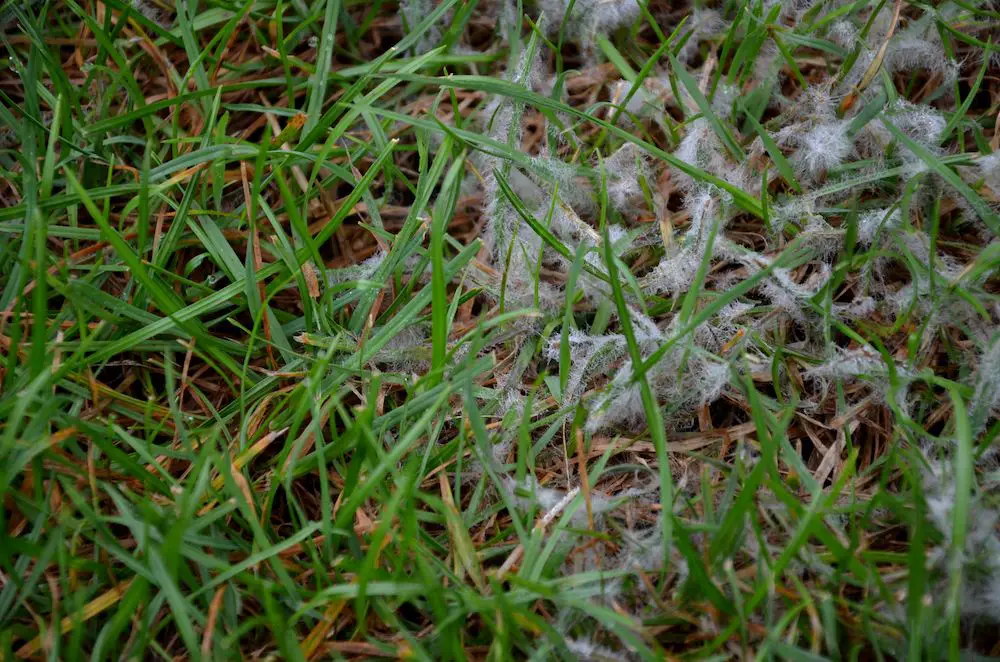Snow mold is a common fungal disease that affects lawns in cold winter climates. It forms grayish-white or pinkish-brown circular patches on the grass that can grow and merge to cover large areas. Treating snow mold requires using a combination of cultural practices and fungicides to prevent infection and reduce disease pressure.
Page Contents
What causes snow mold?
Snow mold is caused by two different fungal organisms – Microdochium nivale which causes gray snow mold, and Typhula incarnata which causes pink snow mold. Both fungi thrive in the cold, wet conditions under the snow cover. The prolonged moisture allows the fungal spores to germinate and infect the grass plants. Snow mold fungi continue to grow and spread throughout winter and peak in spring as the snow melts.
How to identify snow mold
Look for the following signs to identify snow mold in lawns:
- Circular, melted grayish-white patches upto several feet wide on the lawn as snow melts
- Bluish-gray or grayish-white fuzzy fungal growth in the centers of patches on close inspection
- Patches of matted light brown or pinkish-brown grass under melted snow
- Presence of cobweb-like fungal mycelium in the thatch layer
When to treat for snow mold
The timing of snow mold treatment is critical. Here are the best times to treat:
- Fall: Apply preventive fungicide in late fall before first snowfall. This protects grass before fungal infection occurs.
- Late winter: Use a fungicide in late winter when there are intermittent thaws. This targets active fungal growth.
- Spring: Treat damaged areas after snow melts to help turf recover and prevent spreading.
Cultural control methods
Along with fungicides, certain cultural practices can help reduce snow mold damage:
- Improve lawn drainage to reduce moisture and puddling
- Avoid heavy late fall fertilization that can trigger excessive growth
- Mow lawn short before winter to prevent fungal growth on matted grass
- Rake and remove leaf litter that harbors infectious spores
- Allow sunlight to penetrate to lawn areas by pruning trees/shrubs
- Use snow mold resistant grass varieties like fine fescues
Chemical control – Fungicide options
Using preventive fungicide sprays is the most effective way to control snow molds. Some suitable active ingredients include:
| Active ingredient | Examples | Notes |
|---|---|---|
| Chlorothalonil | Daconil, Echo, Broad Spectrum | Protectant fungicide, may require repeat applications |
| PCNB (Pentachloronitrobenzene) | Terraclor, Turfcide, Revere | Long residual activity, cost effective |
| Propiconazole | Banner MAXX, Spectator, Savvi | Systemic control, absorbs into grass plants |
| Iprodione | Chipco 26GT, Lesco 18 Plus | Broad spectrum control, locally systemic |
| Fluoxastrobin | Fame, Fame G, Fame C | Used for gray snow mold control |
Always check fungicide labels for proper application rates, timing, re-entry intervals and turfgrass tolerance.
How to apply snow mold fungicides
Follow these tips for effective application of liquid spray fungicides:
- Spray in dry weather when grass is dry to allow maximum product absorption
- Use a backpack or tank sprayer for small areas, hose-end sprayer for large lawns
- Water in immediately after application or let rainfall assist absorption
- Add a spreader-sticker to spray for better adherence and coverage
- Wear protective clothing and observe re-entry periods
Granular fungicides can also be applied with a drop or rotary spreader and watered in well after application.
Home remedies for snow mold
There are some homemade solutions that may help as supplemental treatments for minor snow mold. These include:
- Diluted hydrogen peroxide spray – Helps break down fungal hyphae
- Baking soda spray – Alters pH for an unfavorable fungal environment
- Cornmeal – Contains a fungus inhibiting compound called chitinase
- Garlic oil spray – Contains antifungal compounds like sulfur and allicin
However, these remedies may not provide the same level of control as commercial fungicides. Test first before applying to the entire lawn.
How to repair snow mold damage
For turf areas damaged severely by snow mold, undertake reseeding or resodding to restore the lawn:
- Rake vigorously and remove dead grass and debris from affected areas
- Reseed with a turf-type tall fescue or perennial ryegrass seed blend
- Starter fertilizer promotes faster seed germination and establishment
- Keep newly seeded areas consistently moist until new grass is 2-3 inches tall
- Alternatively, install new sod in patchy areas for instant results
- Fungicide spray or drench provides protection as new grass establishes
How to prevent snow mold
Prevention is the best approach against severe snow mold damage. Follow these key prevention tips:
- Maintain optimal fertilization and mowing height to promote turfgrass health before winter
- Improve drainage and reduce compaction in problem areas
- Use snow mold resistant grass cultivars suitable for your region
- Remove leaves, debris andexcess thatch to minimize fungal inoculum
- Time fall fungicide application properly before snowfall
- Allow sunlight exposure by pruning encroaching trees and shrubs
Key Takeaways
- Gray and pink snow molds require similar treatment but are caused by different fungal species
- A combination of cultural practices and fungicide application provides the best control
- Time preventive fall or late winter fungicide sprays properly for maximum benefit
- Improve lawn growing conditions and grass health going into winter
- Promptly repair snow mold damage in spring through reseeding or resodding
Conclusion
Snow mold requires a multi-pronged approach relying on sound cultural practices and targeted fungicide use. While the disease is difficult to control once established, taking preventive measures is key to avoiding extensive snow mold issues. With proper treatment timing, vigilant lawn maintenance and preventive care, your lawn can thrive even in harsh winter weather.
